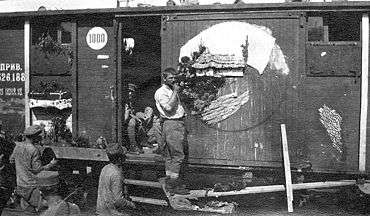Revolt of the Czechoslovak Legion
The Revolt of the Czechoslovak Legion was the armed actions of the Czechoslovak Legions in the Russian Civil War against Bolshevik authorities during May - August, 1918, in Volga, Siberia and Ural regions. This event made possible the anti-Bolshevik activity of the Committee of Members of the Constituent Assembly.
Background
During World War I, ethnic Czechs and Slovaks living in the Russian Empire petitioned Czar Nicholas II to set up a national force to fight against Austria-Hungary. In 1916, the Russian military authorities began to form a Czechoslovak Legion. As of the end of 1917, the Legion had more than 60,000 soldiers; many of them were former POW's from the Austro-Hungarian army.
After the October Revolution in 1917, the Czechoslovak Legion was in a very complicated situation. The Bolsheviks did not want to use it on the Eastern Front, and it was very hard to remove Czechoslovak troops to the Western Front. In March 1918, the Soviet government (under pressure from Germany) stopped the transfer of Czechoslovak troops to France through Arkhangelsk and sent them through Siberia to Vladivostok. The slow evacuation by the Trans-Siberian Railway was exacerbated by transportation shortages – as agreed in the Brest-Litovsk treaty, the Bolsheviks were at the same time repatriating German, Austrian and Hungarian POWs from Siberia. Around the same time Leon Trotsky, then People's Commissar of War, under intense pressure from the Germans, ordered the disarming and arrest of the Legion, thus betraying his promise of safe passage.
Chronology

In May 1918, tensions with the Bolsheviks provoked what is generally referred to as the Revolt of the Legions. Conflict already existed between trains of legionaries going east to fight on the Allied side and German and Austro-Hungarian prisoners (including some Czechs and Slovaks) going west to fight for "the other" side. On 14 May 1918, the legionaries stopped a Hungarian train at Chelyabinsk in the Urals and shot a soldier who had thrown a stone at the Czechs, hitting one of Czechs and injuring him , killing a man. Then the local Bolshevik government arrested some of the Czechoslovaks and ordered them to be executed. Members of the Legion stormed the railway station, freed their men and subsequently occupied the city of Chelyabinsk. This incident triggered further hostilities between the Legion and the Bolsheviks.
Czechoslovaks began to occupy the cities on their route: Chelyabinsk, Petropavlovsk, Kurgan, Novonikolaevsk, Mariinsk, Nizhneudinsk and Kansk. At the same time as the Czechs moved in, Russian officers' organizations overthrew the Bolsheviks in Petropavlovsk and Omsk. Within a month the Whites controlled most of the Trans-Siberian Railway from Lake Baikal to the Ural Mountains regions. During the summer, Bolshevik power in Siberia was totally wiped out.
At the beginning of June legionaries defeated Red Guards near Samara and captured the city. On 8 June 1918, a Komuch was formed there - the first anti-Bolshevik government in Russia. On 13 June, the Provisional Siberian Government was formed in Omsk. The Commander of the 1st Legionary Division Stanislav Čeček gave an order:
...Our detachment - a vanguard of Allied Forces, our only goal - to rebuild anty-Germany front in Russia in collaboration with russians and our allies...
In July, Russian troops commanded by Vladimir Kappel took Syzran, and Czechoslovak troops took Čeček - Kuznetsk, and they began to advance towards Saratov and Kazan. In Western Siberia, Jan Syrový took Tyumen, in Eastern Siberia Radola Gajda took Irkutsk and later Chita.
Retreating

In the autumn, the Red Army began its counter offensive and defeated the Whites on the Eastern front. Hearing about the creation of an independent Czechoslovakia, legionaries began to ask why they had to fight in the Russian civil war. At the beginning of 1919, all Czechoslovak troops began to retreat to the Trans-Siberian Railway. on 27 January 1919, Jan Syrový (at that time commander-in-chief of all Czechoslovak troops in Russia) claimed the Trans-Siberian Railway between Novonikolaevsk and Irkutsk as a "Czechoslovak zone of operation". This made it impossible for the White Army to use the railway for retreating at the end of 1919.
In Irkutsk, to provide safe transit for Czechoslovak trains, Jan Syrový at the beginning of 1920 agreed to hand over Aleksandr Kolchak, who had been stopped by Czechoslovaks, to the representatives of Political Centre. Kolchak was killed by the Political Centre. Because of this, and also an attempted rebellion against the Whites, organized by Radola Gajda in Vladivostok on 17 November 1919, the Whites accused Czechoslovaks of being traitors.
From December 1919, the Czechoslovak Legion started to leave Russia through Vladivostok, and the evacuation was completed in 1920.